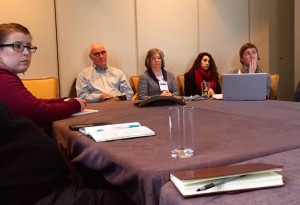
The focus of the discussion at the ACRL Rare Books and Manuscripts Section’s Curators and Conservators Discussion Group on Saturday was on the role that curators and conservators play in relation to materials in offsite storage. Charlotte Priddle, curator and librarian at New York University’s Fales Library, and Beth Kilmarx, curator of rare books at Binghamton University, were the co-conveners for this session.
Nearly every special collections repository sends some items to an offsite storage facility. As a result, curators and conservators are dealing with issues related to access to and transport for those materials on an almost daily basis. When attendees were asked to raise a hand if their institution sent special collections materials, manuscript or print, to an offsite storage facility, all but three people in the room raised their hands. There were 30 people in the room.
The general feeling was that the risk of transporting items to offsite facilities is too great. Concerns stemmed from inappropriate handling and packaging of materials to the negative side effects of changes in temperature between facilities. One attendee suggested leaving a Preservation Environment Monitor (PEM) in the van that transports materials to monitor temperature changes. By doing so, she was able to advocate for a different type of van because the vans that were being used to transport materials had translucent tops, which increased the temperature inside.
Next, the conversation progressed to the criteria used at various institutions for deciding which materials should be sent to offsite facilities. Unlike general stacks collections, special collections repositories cannot rely on circulation data alone to determine which materials are sent offsite. Instead, some institutions send materials that need a more stable environment, while others send things that have good finding aids.
Many attendees expressed concerns about limited space in offsite facilities. For some, these facilities are already nearing capacity, and they are sharing the space with other institutions. As a result, the offsite facilities are moving to a one-copy policy. In turn, this policy is leading to defensive cataloging, so that institutions can prevent their duplicate copies from being weeded out.
Concerns about utilizing offsite storage were abundant in this session, but attendees grudgingly recognized the need for the space that these facilities can offer. As we continue to run out of space, both in our special collections buildings and in our offsite facilities, the need to develop guidelines for the care of materials being sent offsite increases. Additionally, some attendees felt that policies regarding materials in offsite facilities should be made public. Priddle felt that accountability was essential, stating, “What happens when our materials become just a line on a spreadsheet?”


